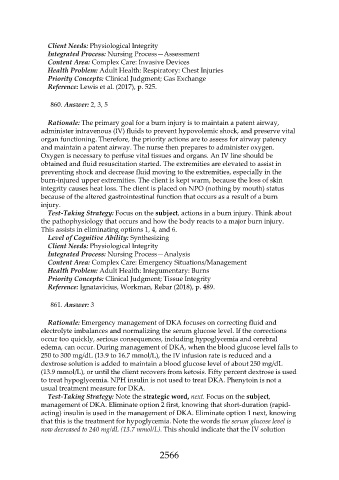Page 2566 - Saunders Comprehensive Review For NCLEX-RN
P. 2566
Client Needs: Physiological Integrity
Integrated Process: Nursing Process—Assessment
Content Area: Complex Care: Invasive Devices
Health Problem: Adult Health: Respiratory: Chest Injuries
Priority Concepts: Clinical Judgment; Gas Exchange
Reference: Lewis et al. (2017), p. 525.
860. Answer: 2, 3, 5
Rationale: The primary goal for a burn injury is to maintain a patent airway,
administer intravenous (IV) fluids to prevent hypovolemic shock, and preserve vital
organ functioning. Therefore, the priority actions are to assess for airway patency
and maintain a patent airway. The nurse then prepares to administer oxygen.
Oxygen is necessary to perfuse vital tissues and organs. An IV line should be
obtained and fluid resuscitation started. The extremities are elevated to assist in
preventing shock and decrease fluid moving to the extremities, especially in the
burn-injured upper extremities. The client is kept warm, because the loss of skin
integrity causes heat loss. The client is placed on NPO (nothing by mouth) status
because of the altered gastrointestinal function that occurs as a result of a burn
injury.
Test-Taking Strategy: Focus on the subject, actions in a burn injury. Think about
the pathophysiology that occurs and how the body reacts to a major burn injury.
This assists in eliminating options 1, 4, and 6.
Level of Cognitive Ability: Synthesizing
Client Needs: Physiological Integrity
Integrated Process: Nursing Process—Analysis
Content Area: Complex Care: Emergency Situations/Management
Health Problem: Adult Health: Integumentary: Burns
Priority Concepts: Clinical Judgment; Tissue Integrity
Reference: Ignatavicius, Workman, Rebar (2018), p. 489.
861. Answer: 3
Rationale: Emergency management of DKA focuses on correcting fluid and
electrolyte imbalances and normalizing the serum glucose level. If the corrections
occur too quickly, serious consequences, including hypoglycemia and cerebral
edema, can occur. During management of DKA, when the blood glucose level falls to
250 to 300 mg/dL (13.9 to 16.7 mmol/L), the IV infusion rate is reduced and a
dextrose solution is added to maintain a blood glucose level of about 250 mg/dL
(13.9 mmol/L), or until the client recovers from ketosis. Fifty percent dextrose is used
to treat hypoglycemia. NPH insulin is not used to treat DKA. Phenytoin is not a
usual treatment measure for DKA.
Test-Taking Strategy: Note the strategic word, next. Focus on the subject,
management of DKA. Eliminate option 2 first, knowing that short-duration (rapid-
acting) insulin is used in the management of DKA. Eliminate option 1 next, knowing
that this is the treatment for hypoglycemia. Note the words the serum glucose level is
now decreased to 240 mg/dL (13.7 mmol/L). This should indicate that the IV solution
2566

